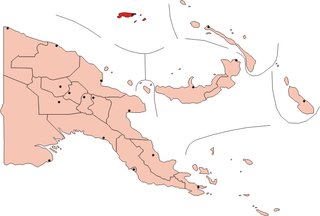
The Admiralty Islands are an archipelago group of 40 islands in the Bismarck Archipelago, to the north of New Guinea in the South Pacific Ocean. These are also sometimes called the Manus Islands, after the largest island.

Pittas are a family, Pittidae, of passerine birds found in Asia, Australasia and Africa. There are 44 species of pittas, all similar in general appearance and habits. The pittas are Old World suboscines, and their closest relatives among other birds are in the genera Smithornis and Calyptomena. Initially placed in a single genus, as of 2009 they have been split into three genera: Pitta, Erythropitta and Hydrornis. Pittas are medium-sized by passerine standards, at 15 to 25 cm (5.9–9.8 in) in length, and stocky, with strong, longish legs and long feet. They have very short tails and stout, slightly decurved bills. Many have brightly coloured plumage.
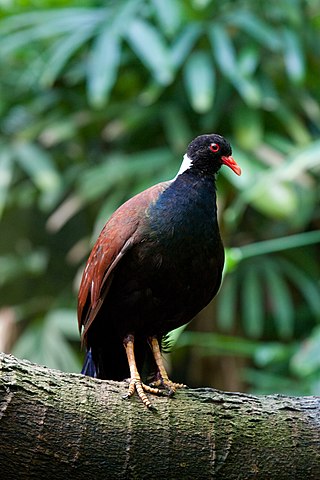
The pheasant pigeon is a species of large terrestrial pigeon. It is the only species of the monotypic genus Otidiphaps. The pheasant pigeon is found in the primary rainforests of New Guinea and nearby islands. It ranges primarily over hilly and lower mountain areas, but can also be found in lowlands.

The greater lophorina, formerly a subspecies of the superb bird-of-paradise, is a species of passerine bird in the bird-of-paradise family Paradisaeidae. It is found in the central and northeast montane regions of New Guinea.

The Manus fantail is a bird species endemic to the Admiralty Islands of Papua New Guinea.

The rainbow pitta is a small passerine bird in the pitta family, Pittidae, endemic to northern Australia, most closely related to the superb pitta of Manus Island. It has a velvet black head with chestnut stripes above the eyes, olive green upper parts, black underparts, a bright red belly and an olive green tail. An Australian endemic, it lives in the monsoon forests and in some drier eucalypt forests.

The red-capped flowerpecker is a small passerine bird endemic to, and widespread within, New Guinea and adjacent islands. It has recently been split from the olive-crowned flowerpecker Dicaeum pectorale.
The Papuan spinetail, also known as the Papuan needletail, New Guinea spine-tailed swift or Papuan spine-tailed swift, is a small, stocky swift with a short, rounded tail and very fast flight. Head and upperparts glossy blue-black, white or whitish belly and undertail coverts, dark underwing with pale central stripe. The small spines at the end of the tail are not visible in flight.
The Bougainville thicketbird is a bird species. It had been placed in the "Old World warbler" family Sylviidae, but it does not seem to be a close relative of the typical warblers; probably it belongs in the grass warbler family Locustellidae. It is endemic to Bougainville Island. Its natural habitat is subtropical or tropical dry lowland grassland. It used to be considered conspecific with the Santo thicketbird and the New Britain thicketbird.
Meek's pygmy parrot, also known as the yellow-breasted pigmy parrot, is a species of small parrot in the family Psittacidae. It is endemic to Papua New Guinea.

The canary flyrobin, also known as the Papuan flycatcher, canary robin, canary flycatcher, or montane flycatcher, is a species of bird in the family Petroicidae. It is found in New Guinea. Its natural habitat is subtropical or tropical moist montane forests with elevations from 1,100–3,500 m (3,609–11,483 ft). Currently, its population is believed to be stable.

The Biak monarch, or Biak monarch flycatcher, is a species of bird in the family Monarchidae. It is endemic to Biak Island, Indonesia.
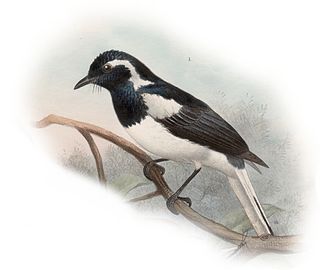
The Manus monarch, also called the Admiralty Islands monarch, the Admiralty monarch, the Admiralty pied monarch, the somber monarch and the unhappy monarch, is a species of bird in the family Monarchidae. It is endemic to the Admiralty Islands of Papua New Guinea.
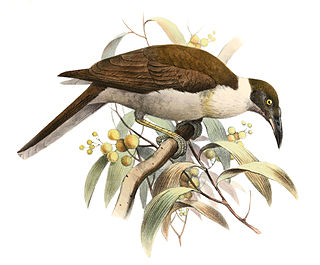
The Manus friarbird or white-naped friarbird, also known as the chauka is a species of bird in the Honeyeater family, or Meliphagidae. It is endemic to the Manus Province of Papua New Guinea.
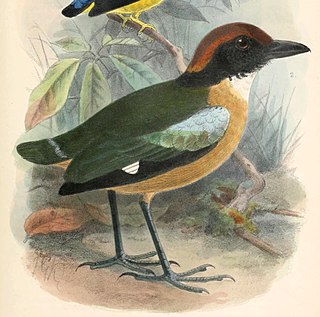
The black-faced pitta is a species of bird in the family Pittidae. It is found on Bougainville Island in Papua New Guinea, and Choiseul Island as well as Santa Isabel Island in the Solomon Islands. Its natural habitat is subtropical or tropical moist lowland forest. It is threatened by habitat loss and most certainly by introduced predators and/or competitors.
The Geelvink imperial pigeon is a species of bird in the family Columbidae. It is endemic to Indonesia's Schouten Islands and Mios Num Island, which lie north of New Guinea. Its natural habitats are tropical moist lowland forests and mangrove forests.
The Louisiade pitta is a species of the pitta. It was considered a subspecies of the red-bellied pitta. It is endemic to Rossel Island in the Louisiade Archipelago in Papua New Guinea. Its natural habitat is subtropical or tropical moist lowland forests. It may be threatened by habitat loss, but is currently listed by the IUCN as Data Deficient as there have been no definite records since the type specimen was collected in 1898. However an expedition to the island in 2014 revealed that local people said they still encountered it. In 2022, British tourist Michael Smith found two alive individuals with clear photograph evidence.
The Bismarck pitta or New Ireland pitta is a species of pitta. It was formerly considered conspecific with the red-bellied pitta. It is endemic to the Bismarck Archipelago in Papua New Guinea. Its natural habitat is subtropical or tropical moist lowland forests. It is threatened by habitat loss.
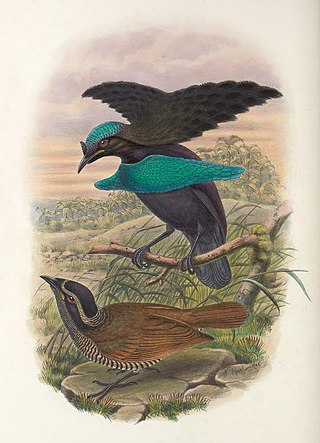
The lesser lophorina, also known as lesser superb bird-of-paradise or rasping bird-of-paradise, is a species of passerine bird in the bird-of-paradise family Paradisaeidae.

The Vogelkop lophorina, formerly part of the superb bird-of-paradise complex, is a species of passerine bird in the bird-of-paradise family Paradisaeidae. It is found in montane northwest New Guinea.
















